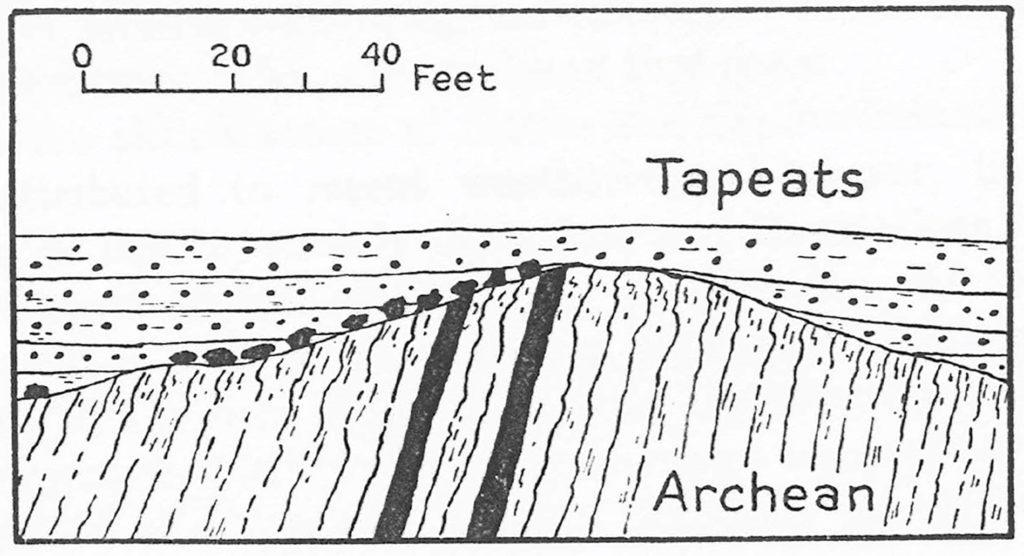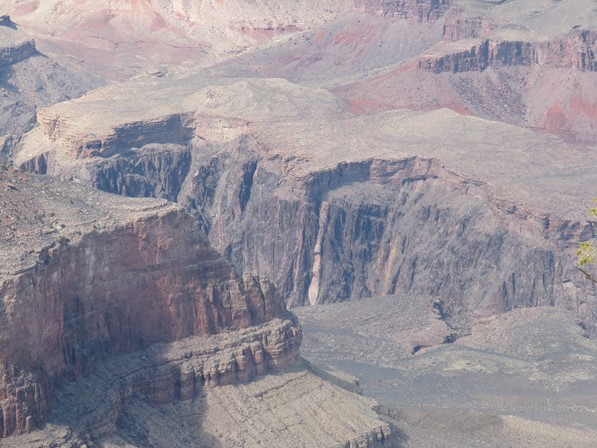Sighting of a Cambrian Island from the South Rim of the Grand Canyon
Markes E. Johnson

The rocks studied by geologists are often described in a standardized code that delimits the words employed, right down to the choice of color, grain size and fabric among other physical attributes. The code is a product of the International Union of Geological Sciences, from which students may be trained for proficiency. I myself taught from the code for many years in the capstone geology course at a New England college. Geology students elsewhere at the same level of experience likely learn these same lessons, whether their classroom is somewhere in Spain, Finland, Kenya, or Australia. This is not to say that geologists-in-training have the impetus for individual expression drummed out of them, but rather to suggest that any two geologists from anywhere in the world should learn to describe the same rock in a mutually understandable way. What comes next is the larger challenge: interpreting how a rock came to exist in a particular place. Two (or more) geologists standing at the same outcrop may well disagree about the origin of a particular rock. After all, rocks that look superficially similar may have formed under very different settings. The mature geologist learns through experience to seek clues that tell that story in a wider context.
A mile deep and as much as eighteen miles wide, the Grand Canyon of Arizona is the world’s largest exposure of rock layers; it includes almost every type of rock known to human inquiry. My introduction to the place occurred when I was a geology student in 1968 and participated in an excursion led by professors from the Midwestern university where I studied. Quite simply, the Grand Canyon is a unique location where an impressionable student can view a great many different kinds of rock all in one place and all at the same time. Each layer tells a different story about how it came to be deposited at a particular time in a particular environment. Later, when I began my teaching career, I organized a trip for my own students so they too might experience the canyon’s magnificence. To prepare, I got permission from the park service to collect a rock sample from each of the canyon’s many rock formations. My backpack was quite heavy when we finally emerged at the top of the Bright Angel Trail. Thereafter, the canyon’s architecture lent itself to some of the standard content in my introductory lecture courses.
A mile deep and as much as eighteen miles wide, the Grand Canyon of Arizona is the world’s largest exposure of rock layers; it includes almost every type of rock known to human inquiry.
Once a precise description and masterful interpretation of a rock are set in print, the example offers inspiration. Such a publication is sure to enjoy a long “shelf life” consulted by those who are drawn to the same geographic area. During a recent trip to the Grand Canyon as a host and study leader for alumni from Williams College, I paused to celebrate just such a paper from 1940 by the geologist Robert P. Sharp.[i] His long and eventful career was at Caltech (California Institute of Technology), where he began as a student and eventually became a professor. The work was published in a prestigious journal barely six years after Sharp earned his bachelor’s degree. His paper was known to me well before this visit. I discovered it forty-five years after its publication when I had begun to canvass the literature on islands preserved in the rock record from places all around the world. My fixation led to my latest book, Islands in Deep Time, which features a chapter on islands from 500 million years ago in what is now North America. The Grand Canyon dissects Earth’s crust at the far edge of a smaller continent a bit prior to the emergence of the Baraboo Archipelago in present-day southern Wisconsin, but the two regions share much in common.[ii]
I have always visited the Grand Canyon as a tourist, not to conduct my own independent fieldwork. The Cambrian Baraboo Archipelago is a place where more than a dozen paleoislands (composed of dense quartzite rock) rise above the farmlands as three-dimensional monadnocks. In contrast, the powerful Colorado River cuts deep through today’s Arizona landscape to expose similar Cambrian islands much like a cross-section. The canyon’s south rim looks across the enormous gap cut by the river over the last few million years. But the river is mostly hidden from sight as it flows through a canyon within a canyon. The hard metamorphic rocks of the inner gorge pinch the river’s flow at a deeper level than the softer sedimentary rocks on the adjacent Tonto Plateau. The plateau is the base of the outer canyon, which is readily viewed from a pathway that extends all along the south rim. Sharp’s study site can be spied from afar from many points here. His 1940 paper employs the term monadnock, a word commonly used by geomorphologists since 1895 to denote a physical prominence of bedrock resistant to erosion that projects above the surrounding landscape. In his own words, Sharp sets the stage for an island story:
Below the 120 Mile Rapids, a rounded knob of Archean schist projects into the basal Tapeats sandstone. Near the crest of the knob, two quartz veins crop out, and angular fragments of quartz derived from these veins now lie on the slopes of the knob. If the [overlying] sandstone were removed, the relations would be essentially those on any present-day hillock containing an exposed quartz vein.
The confirmation of Sharp’s study site is certain because his drawing of the locality in the published paper matches against today’s view from the south rim. The all-important quartz veins mentioned in the text are visible even from a great distance. As the ocean rose around the crown of schist and overtopped it during the Cambrian, waves eroded bits of quartz and carried them down the slope of the flooded hill, where they were buried under sand that hardened into sandstone. Based on Sharp’s graphics, the maximum elevation of the island above Cambrian sea level was about 40 feet, but the lateral radius of the island was much greater.
The formal name for the metamorphic rock at the core of the paleoisland is the Vishnu schist, and the much younger rocks that overlap the schist belong to the Tapeats sandstone. As a young geologist, Sharp explored the junction of the outer and inner canyons more than halfway inside the great defile. He must have observed broken bits of quartz within the Tapeats sandstone up close. The sandstone sample collected by me in 1978 includes trace fossils after marine worms that left burrows in the soft sand around the island. The next rock layer succeeding the Tapeats sandstone, called the Bright Angel shale, has a more varied set of fossils, including trilobites and brachiopods. Although I have searched for fossils that might represent intertidal life forms around the Baraboo islands, such evidence has eluded me. But small trilobites and brachiopods dwelled offshore the Baraboo Islands of Wisconsin, much like those in the Bright Angel shale. The lasting appeal of Sharp’s 1940 paper is that it adds nuanced details, accurately described, to what can be gleaned from an ancient seascape spread widely across a continent flooded by seawater some 500 million years ago.
The excavation of the Colorado River in today’s Grand Canyon is worth thinking about, especially now in the context of global warming. The Colorado River drops a vertical distance of more than 3,000 feet over its 1,450-mile descent from the Rocky Mountains to Mexico’s Gulf of California. The mile-deep defile at the Grand Canyon amounts to more than the river’s fall from end to end and signifies that the region around the canyon had been subject to gradual uplift over the last few million years as the river cut ever downward. That’s impressive, but equally remarkable is the fact that the canyon’s eighteen-mile girth also required extensive erosion over the same duration. The ongoing widening of the canyon is due to a multitude of small tributary streams that enter the canyon from sources beyond its north and south rims. The first descent of the Colorado River was led by John Wesley Powell during a three-month expedition in 1869. He left a written account of the ordeal running some eighty rapids in a half-dozen wooden boats within the Grand Canyon.[iii] The rapids were already a major challenge, but Powell’s group also encountered rainstorms while on the river. Powell described the danger as follows:
It rains. Rapidly, little rills are formed above, and these soon grow into brooks, and the brooks grow into cascades, adding their wild music to the roar of the river. When the rain ceases, the rills, brooks, and creeks run dry. The waters that fall during the rain on these steep rocks are gathered at once into the river; they could scarcely be poured in more suddenly if some vast spout ran from the clouds to the stream itself. When a storm bursts over the canyon, a side gulch is dangerous, for a sudden flood may come and the in-pouring waters will raise the river so as to hide the rocks.
Eyewitnesses recorded similar accounts of storms that fed waterfalls to spill over the canyon rims and down its steep sides. The stormwater can trigger rock slides that may tumble down a great distance all the way to the river bottom, resulting in boulder-filled rapids that persist as whitewater stretches for those who do river-rafting yet today. At Mile 120, the fall near Sharp’s paleoisland is called Blacktail Rapid, and it is a Class II whitewater rapid. It means that Mile 120 is a spot on the river that has absorbed more than a normal share of boulders from flood-related rock slides.
Climatologists recognize that the American Southwest is impacted by the El Niño Southern Oscillation (ENSO) over the nearby Pacific Ocean, with a consequential history of flooding and landslides interspersed by periods of drought throughout the coastal lands of both North and South America. The cycle appears to repeat on an episodic basis with months of increased rainfall during El Niño years, separated every six to eight years by dry spells during La Niña years. Major flooding on the Colorado River is well documented to have occurred during excessive intervals of rainfall in 1966, 1983, 1994, and 2004—all El Niño years. At the upstream Glen Canyon Dam in 1983, engineers were caught unawares by the sudden, rapid filling of Lake Powell to capacity. The impoundment came perilously close to overflowing the dam and emergency measures had to be undertaken to limit damage to the structure. A long period of drought has plagued the region in recent years, and forest fires have been widespread across the American West. By all indications, we are about to enter an El Niño phase triggered by abnormally high sea-surface temperatures (SSTs) and low-pressure atmospheric circulation over marine coastal currents converging at the equator. The accompanying rainstorms promise to refill depleted reservoirs like Lake Powell at Glen Canyon Dam and Lake Mead at Hoover Dam. Under the influence of global warming, however, the severity of hurricanes and coastal flooding related to El Niño conditions is expected to intensify.
Markes E. Johnson is the Charles L. MacMillan Professor of Natural Science Emeritus at Williams College, and the author of Islands in Deep Time: Ancient Landscapes Lost and Found.







